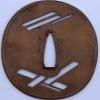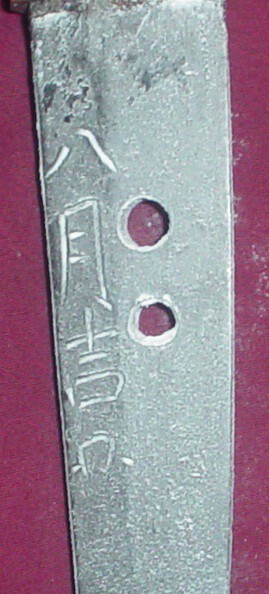-
Posts
868 -
Joined
-
Last visited
-
Days Won
2
Content Type
Profiles
Forums
Events
Store
Downloads
Gallery
Everything posted by Lee Bray
-
Jason, Norimitsu and son? If you're going to ignore the opinion of some of the most knowledgeable members using the best references around and make up your own smiths, maybe you should just send it straight to shinsa and save everyone lots of time?
-
Either a drunken polisher or camera angle problems. Check the first picture of the side by side nakago. The lines look straight in that shot, though the shinogi is somewhat crooked. Perhaps this points at some 'bending' of the nakago but I don't think so based on the resultant nakago.
-
Well, for me in this instance, keeping the original habaki was about the art, not artifact. It's an artistic habaki and to recreate one the same...well, it just wasn't needed, it fitted. To discard it for a new one would be foolish, in my opinion.
-
I say keep the old if it still fits and is still functional. A new polish doesn't necessarily mean that the habaki loses fit and as it will not be cut with, I don't see the need for a super tight fit. I have a Kamakura/Nambokucho tanto here in signed koshirae by Kajikawa, with a two piece gold and silver habaki in the shape of Mt.Fuji. It's just come back from the restorer, new polish and shirasaya and we kept the old habaki. Fits perfectly and I much prefer the fact the habaki is old and original to the koshirae, not modern.
-
Thanks, Gentlemen. I guess the lack of year confused me. First time I've seen that...anyone know of the relevance? It's on a sword signed Harima (no) Kami Minamoto Kunitsugu; the few in Hawley's are around the Kanbun era.
-
-

Please help identify sword inherited from grandfather, WW2
Lee Bray replied to UrQuattro's topic in Military Swords of Japan
Grey - I'm also dubious about the nakago - shape, patina and the mekugi ana(peg holes). Overall shape of the sword and the way it fits the shirasaya seem a little suspect to me as well, but it's only my opinion. My 'gut' says fake sword fitted to a good shirasaya or possibly a real sword very poorly 'restored'. I hope I'm wrong. -

Please help identify sword inherited from grandfather, WW2
Lee Bray replied to UrQuattro's topic in Military Swords of Japan
Hi Michael. Just so everyone is aware, I'm the fella expressing scepticism toward this blade on the other forum. Regarding the tip and the wavy line(hamon); the hamon curves around the tip of the sword following the sharp edge to some degree. This is called the Boshi. Should the tip sustain damage for some reason, when it is repaired, this boshi is decreased and obviously it can never be replaced. Therefore professional polishers take great care restoring the tip. Your sword doesn't show that care, unfortunately. Compare the shape of your kissaki(tip) with the sword in the link I provided on the other forum. Go to the home page of that site and find other swords to compare kissaki shape. You'll see what I mean. -

YASUMITSU FIRST GENERATION BIZEN - IDENTIFICATION HELP
Lee Bray replied to NihontoEurope's topic in Nihonto
-

YASUMITSU FIRST GENERATION BIZEN - IDENTIFICATION HELP
Lee Bray replied to NihontoEurope's topic in Nihonto
You're working from the 1966 edition of Hawley's, apparently without the introductory pages of Vol.1 or the complete Vol.2. K & S represent the Koto or Shinto volumes of the Nihon Toko Jiten, one of Hawley's references. The addenda are extra smiths compiled in Vol.2. In your image, there are four extra smiths for the addenda. -
Looks more like a Shishi dog with the short face and hair.
-
http://home.earthlink.net/~steinrl/unji.htm That should help.
-
Thanks, Chris... I found this: Tanaka Kiyotoshi (Japanese, 1804-1876) Also known as * 田中淸壽 (竜叟法眼) * Ryuso Hogen * Ikkashi * Kiyotoshi Tanaka :so I think Moriyama San has it correct. Thanks guys. I melted my eyeballs with Self & Hirose on this one...
-
-
Nobuyoshi it is, though no idea which one.
-
Certainly not out of line. If the gentleman cannot identify the age and school or maker of the blade then how can he know how to restore it to its proper state? Obviously he can't. No doubt a good bladesmith and craftsman but not the qualifications needed for Nihonto restoration. It's restoration, not putting a shiny finish on a blade. But argue with the wind. You'll get just as far.
-
:D Good information, George, thanks. From what I'm finding, Noriyuki II had a few earlier names; age 14 - Matsujiro, age 17 - Masakata, age 25 - Noriyuki. Masakata...Norimasa...Noriyuki? Edit - It seems Itoryuken was a name used by his teacher and his teacher's teacher on occasion.
-
Good stuff, thanks guys. Toryuken would have been his first name? George - it's a mei of a kodzuka I'm thinking of buying from a dealer. His information was - "Norinobu. Later became Noriyuki II." So it purports to be the early mei of Hamano Noriyuki II (1771 - 1852) All examples I can find of his mei are signed with his Noriyuki mei. The work is very good but seems to be lacking the quality of his later pieces. So I am unsure. :D
-
Is it allowable to show a picture of the book page? I wrote most of the text from the page in my previous post. Robert Haynes also refers to the design as the kanji Dai.
-
Using 'Self & Hirose' and far too much time, I think this reads Sho Ryu Ken Nori Nobu - Shoryuken Norinobu. Not sure about the first kanji but fairly confident on the rest. Could I please get a correction or confirmation?
-
Ah, I overlooked Mr.Rose's comment on the burn mark and bend and stand corrected.
-
Page 167 of the above book. As Thierry described above, cast iron plate made by a tetsubin-shi - caster of iron tea kettles. "It has an inscription: Tosa Kuni Ju Myochin Munetoshi, and was taken from his original work." "Unfortunately the example by Munetoshi has not been recorded so far." Apparently casting was very expensive due to the amount of charcoal needed. It goes on to say, "Not enough attention has been paid to cast iron fittings. This is one of the best examples found so far."
-
Whilst John's opinion is a valuable tool and a great resource(seriously - no condescension on my part), I'd have to say that one picture of a stain on the monouchi taken from a distance should not dismiss the sword. It may be heat, it may be rust, it may be some muppet decided to try and cold blue the blade and had second thoughts. I just noticed the admin crop of the pics so maybe the details were viewable earlier but I wouldn't write it off just yet because of that.
-
A table and soft cloth or paper would be better for taking pictures. Next time... Looking more at the shape of the nakago, perhaps it was altered to fit later police or military sword mounts. The mark/character on your tang maybe an identifier whilst in the armoury to keep blade and fittings together while being worked on. Pure speculation on my part - the tang shape reminded me of this thread - viewtopic.php?f=15&t=10246&p=85747&hilit=police#p85747 Even if this were the case and you have a traditional blade altered to fit military/police fittings, I still don't think the blade looks worthy of major restoration. The kissaki geometry looks altered, the cutting edge seems wavy - indicating bad polishing, the nakago is, sorry to be frank, unsightly... I still think you're looking at the top section of a katana, so at the least you probably have a traditionally made blade and not a modern fake.
-
It looks like a very crude shortened wakizashi, made either from a broken katana or longer wakizashi. You're not going to be able to judge school, smith, etc from the blade in its current condition. The blade itself is not worth restoring, in my opinion. If this sword means a lot to you, and, as you say, you've been trying hard to study and read up on the subject, I suggest you don't hang it upside down from a steel nail on your wall.






